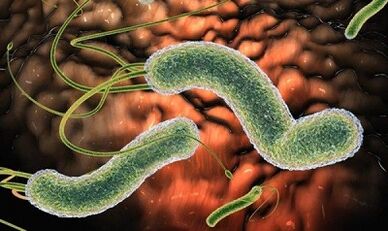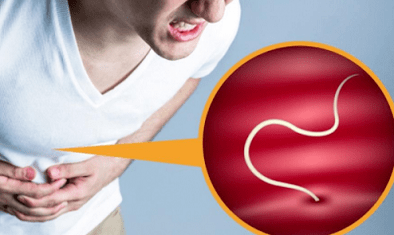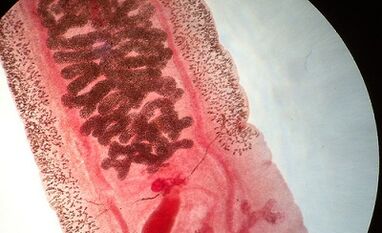
Among patients, a severe misconception is that helminths live only in the intestine.However, one cannot deny the fact that parasites in human blood are as widely wide as other types of helm.The identification and timely therapy of such pathological states require special attention, because when entering the bloodstream, a small socket can reach absolutely any organ.
Symptoms and painful sensations that cause blood worms in humans can be different in both manifestations and in the degree of their severity.It is important to initiate treatment in a timely manner and prevent the additional spread of parasites in the human body in order to avoid complex consequences in a timely manner.Initially, it is necessary to find out how worms appear in the blood.
Types of parasites defining the bloodstream
Nothing is so complicated by the production of the right differential diagnosis as a great spread of symptoms that manifest themselves in patients with parasites in the blood.Several types of helminths cause different signs.In case of blood infection with blood or blood vessels, the patient needs to undergo a complete medical examination that will help identify the type of parasite and determine the proper treatment of pathological condition.
There are several parasites capable of living in human blood:
- Babesia;
- Plasmodium malaria;
- Tripanosoma;
- Ankylostoma;
- Trichinella;
- Toxoplasma;
- Toksokara.
Most helminths enters the human body after an insect bite.Such parasites of the circulatory canal are more dangerous for children.They affect the proper development of the organs, the growth of the entire organism and the state of the immune system.Many people can live with parasites for years and not even suspect that they are infected.
General symptoms of parasitic blood poisoning
Each individual type of parasites in human blood has symptoms that are characteristic only for this disease.
However, there are several characteristic signs of any kind of Helminthose:
- weakness;
- dizziness, headache;
- nausea, vomiting;
- It is possible to increase the total body temperature;
- limb and whole body pain;
- Loss of consciousness attacks are possible.
All of these symptoms are the main manifestations of increasing the content of toxic substances in the body.In the first appearance, it is necessary to contact a medical institution, where doctors will conduct all necessary tests and procedures, which will more accurately determine the cause of this state.
Babesiosis: symptoms, diagnosis and treatment
Babesia are small parasites that enter the human body after a bite of an ixodic tick.These simpler organisms quickly penetrate the erythrocyte membrane inside and begin their difficult life cycle.The disease is widely used in hot regions, where clan mites live.
In most cases, the disease continues without obvious symptoms in adults and children.
However, when the disease appears and is developed, characteristic resources are observed:
- hemolytic anemia;
- fever at 39-40 degrees;
- chills;
- Increased perspiration.
Similar symptoms appear at the latest 4 weeks after tick bite.After the incubation period, the chances of identifying the disease are much higher.
The disease can only be diagnosed under specialized laboratory conditions.For this reason, there is not so many data on the spread of the disease and its symptoms.
However, the assistant doctor should take a number of measures to identify pathogenic alien agents in the patient's body:
- General blood test;
- Serological tests for antibodies for women;
- polymerase chain reaction;
- Microscopic examination of blood smear (hymse color).
Treatment is mainly performed with antiprotozoan medications.Usually, the course of receiving these funds lasts no more than 10 days, but may continue in patients with a recurring form of the disease.The treatment of asymptomatic patients is performed only when the causative agent of babusiosis is detected in the blood during re -analysis, which is performed a few months after the initial detection, when the participating disease was recurrent.
Tripanosomiasis: symptoms, diagnosis, treatment

Tripanosomiasis, another sleepy disease, is widespread in countries in the tropical and subtropical climate and is rarely found in temperate latitudes.The causative agent of the disease is a tripanosome.This is a small parasite.Having looked at the parasite photo made using an electronic microscope, you can distinguish flagella and a membrane along the entire simpler body length.
The disease and its symptoms develop in two complete stages.In the first stage, the parasite penetrates the human red blood cells and begins its active reproduction.
This stage can be recognized by the following signs:
- fever attacks up to 7 days;
- headaches, weakness;
- joint pain and limbs;
- severe itching;
- The appearance of red laughs at the site of inflamed lymph nodes.
In the second stage of the disease, the tripanosome penetrates the central nervous system through the hematoencephalic barrier.This stage is characterized by a severe cycle of sleep and severe waking - the main symptom of the disease.
In addition, in the patient in the second stage of the sleepy disease may appear:
- cloudy consciousness;
- tremendous muscle, weakness;
- paralyzed members;
- apathy;
- irritability;
- Aggression against others.
It is necessary to start treatment as soon as possible, otherwise it is not the most favorable result.Progressing, the disease leads to the appearance of organ failure of various body systems at the same time, whose consequence is the death of the patient.
The diagnosis of sleepy diseases is based on patient symptoms and microbiological studies for the presence of blood trigons, lymph and purulent liquid taken from Shancra.With positive samples, treatment is urgently prescribed.
A good prognosis can be done when the disease can be detected in the hemolytic stage.At this time, very toxic medications are prescribed, but in general the treatment is well tolerated by the patient's body.
However, when the disease can recognize only in the second stage, the prognosis is not always comforting.To treat such a pathological condition, it is necessary to use serious and toxic medications that may penetrate the central nervous system protective barrier.
Malaria: symptoms and treatment

Malaria plasmodium infection occurs through a mosquito bite.Through the salivary glands of the females, the parasite penetrates a person's bloodstream, is transferred with a blood flow to the liver, where the first stages of metamorphosis pass and then enter the bloodstream again and affect red blood cells.
The incubation period of the disease lasts up to 25 days.So the first symptoms of malaria manifest themselves:
- a sharp increase in body temperature;
- headache, weakness;
- hemolytic anemia;
- Yellowness of the skin;
- nausea, vomiting;
- joint pain, pain all over the body;
- seizure attacks;
- The emergence of products from the destruction of red blood cells in the urine.
Basically, the disease is widespread in hot and hot regions, so its diagnosis is based only on the symptoms and history of the patient's life that has manifested over time.Frequent trips to equatorial countries can cause the development of the disease.In addition, standard blood tests and a microbiological examination of body fluids are performed.
The therapy is prescribed depending on the type of disease and its severity and is mainly performed using antimallard medications.
Ankylosomosis: symptoms, diagnosis and treatment
The parasites that cause the disease live in the intestines genes and feed on the blood cells of the master's body.The worms penetrate a person's skin and begin migration to the gut.In the process of movement around the body, the parasites with blood flow fall into the lungs, then pass along the bronchi in the trachea and the upper respiratory tract, where they cause a swallowing reflection and thus reach the intestine on the walls of which they are fixed.
In rare cases, worms of worms cannot successfully complete their migration and remain under the skin of a person.In the photo, a similar process resembles small, thin snakes under the patient's skin.

Eating blood, worms cause the development of iron deficiency anemia in an infected person.The most dangerous when worms penetrate the children's body.Lack of iron, protein and other components necessary for the development of a child can cause mental retardation, growth retardation and physical inferiority.
The main symptoms of ankylosomosis:
- Iron deficiency anemia;
- fever attacks;
- abdomen pain;
- nausea, vomiting;
- diarrhea, constipation;
- severe body weight loss;
- It is possible to cough infectious diseases of the upper respiratory tract during the migration of the larval stages of the parasite.
Among the diagnostic measures, a general blood test, feces and urine analysis, an ultrasound examination of the digestive system is distinguished.The identification of parasites becomes a good reason to initiate immediate treatment and the prevention of pathological conditions associated with the impaired functioning of respiratory, digestive and circulatory systems of the patient's body.
The treatment is performed by a unique intake of the anti -helmintical drug.Therapy is supplemented with the use of vitamin and mineral complexes, allowing to soften the consequences of hemoglobin deficiency.
Toxocarosis: Symptoms and Treatment
The causative agents of this disease are round helminths, which a person can obtain after prolonged communication with pets that did not undergo deworming by eating uninsy vegetables and fruits.The human body becomes an intermediate host of the parasite.
Entering the gut, the larvae hatch of eggs and begin to "pierce" the intestinal wall, penetrating the bloodstream.With blood flow, helminths migrate to any system of the human body.The result of worm migration is a serious liver, heart, central nervous system and vision organs.

The main symptoms of infection of body toxocracles:
- increasing the total body temperature;
- the appearance of intense pain in the abdomen;
- weakness, dizziness;
- the appearance of an allergic eruption on the skin;
- strong cough at night;
- Convulsions, muscles and joint pain.
The diagnosis of the disease is quite difficult.It is necessary to perform serious microbiological and allergological tests for which a specialized laboratory is required:
- polymerase chain reaction;
- Immunorvento analysis;
- Serological tests;
- Ultrasound examination of organ;
- Magnetic resonance imaging and computed tomography.
Severe anti -helmintic therapy is performed only when severe brain damage is detected, the patient's heart muscle.Often, the disease goes independently, since the larval stage cannot become an adult individual in the body of an intermediate host.
However, it is necessary to consider the damage that migratory worms can cause to the patient.Support therapy must be performed and take the necessary measures to prevent the development of serious pathological processes in the liver, cardiovascular and others.
Conclusion
Any parasites are dangerous to the human body.If questions arise, “what parasites live or use blood as a transport system”, “how to determine correctly or not”, “how to treat them and what to take”, it is better to contact a parasitologist and not make independent decisions.Treatment and prevention of parasitic diseases are a decision that a qualified doctor should make.



























